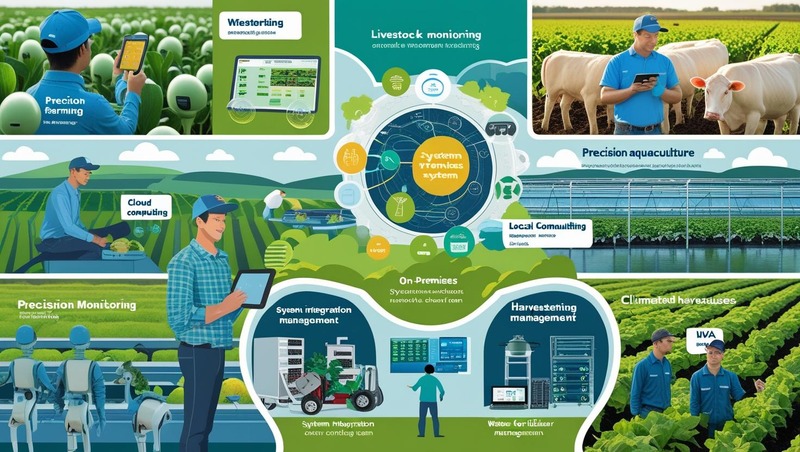The agricultural sector is undergoing a radical transformation in 2025, powered by the rapid advancement of smart farming technologies. These innovations are reshaping how farmers manage crops, livestock, and resources, ushering in a new era of precision, sustainability, and efficiency. As the world faces mounting pressure to increase food production amid climate change and dwindling natural resources, smart farming technologies are proving to be essential in driving productivity while minimizing environmental impact.
At the forefront of this revolution is the use of IoT (Internet of Things) in agriculture. IoT-enabled sensors collect real-time data on soil health, moisture levels, crop growth, and weather conditions, allowing farmers to make data-driven decisions. This technology enhances resource management and reduces waste by ensuring that water and fertilizers are applied exactly where and when needed.
Download PDF Brochure @ https://www.marketsandmarkets.com/pdfdownloadNew.asp?id=239736790

Artificial Intelligence (AI) and Machine Learning (ML) are playing a transformative role in analyzing large volumes of agricultural data. These technologies provide actionable insights for crop health monitoring, disease detection, and yield prediction. AI-powered platforms also enable automated decision-making, helping farmers respond quickly to changing conditions and optimize every stage of the farming cycle.
Drones and unmanned aerial vehicles (UAVs) have become essential tools for modern farmers. Equipped with high-resolution cameras and multispectral sensors, drones provide aerial imagery that helps monitor crop health, detect pest infestations, and assess field conditions. Their ability to cover large areas quickly and efficiently is saving farmers valuable time and resources.
Smart irrigation systems are another game-changer in 2025. These systems use weather forecasts, soil moisture sensors, and AI algorithms to automate and optimize water usage. In regions facing water scarcity, smart irrigation is helping reduce water consumption while ensuring that crops receive the precise amount of hydration they need to thrive.
The rise of autonomous tractors and farm robots is revolutionizing labor-intensive tasks. These machines can plow, plant, weed, and harvest crops with minimal human intervention. By reducing reliance on manual labor and operating around the clock, autonomous equipment increases operational efficiency and lowers production costs.
Blockchain technology is emerging as a powerful tool for enhancing transparency and traceability in the agricultural supply chain. From seed to shelf, blockchain ensures the authenticity and safety of food products by recording every transaction in a tamper-proof ledger. This builds trust among consumers and helps producers comply with regulatory requirements.
Agricultural drones and satellite imaging are improving the precision and accuracy of field assessments. These technologies deliver crucial insights into crop health, soil conditions, and weather patterns. Farmers can use this data to make informed decisions, optimize inputs, and boost overall farm productivity.
Livestock monitoring systems are enabling farmers to track animal health, behavior, and location in real-time. Wearable sensors and smart tags help detect early signs of illness, monitor feeding habits, and improve breeding efficiency. This results in healthier livestock and increased profitability for farmers.
Vertical farming and hydroponics are becoming more mainstream in urban areas. These controlled environment agriculture (CEA) systems allow crops to be grown indoors with minimal space and water. Using LED lighting, climate control, and nutrient-rich solutions, these technologies provide year-round production with high yields.
Finally, mobile apps and farm management software are central to digital agriculture in 2025. These tools offer real-time analytics, crop planning, inventory tracking, and financial reporting—all accessible via smartphones and tablets. They empower farmers to manage their operations more effectively and make informed business decisions.
Together, these top 10 smart farming technologies are redefining agriculture in 2025. As they become increasingly accessible and affordable, farmers across the globe are embracing innovation to build a more sustainable, resilient, and productive agricultural future.
Frequently Asked Questions (FAQs) on Smart Agriculture Market
1. What is Smart Agriculture?
Smart agriculture refers to the use of advanced technologies such as the Internet of Things (IoT), Artificial Intelligence (AI), drones, sensors, GPS, and big data analytics to optimize farming operations. It focuses on improving productivity, efficiency, and sustainability while minimizing environmental impact.
2. How does Smart Agriculture benefit farmers?
Smart agriculture helps farmers make data-driven decisions, reduces waste of resources like water and fertilizers, improves crop yields, lowers input costs, and enables real-time monitoring of farming activities. It also enhances resilience to climate change and supports sustainable farming practices.
3. What are the major components of the Smart Agriculture market?
The smart agriculture market is primarily segmented into hardware (sensors, drones, GPS, automated equipment), software (farm management platforms, analytics tools), and services (consulting, support, training, and system integration).
4. What are the key applications of Smart Agriculture?
Major applications include precision farming, livestock monitoring, smart greenhouse farming, aquaculture, and smart irrigation. These applications help in efficient resource management, automated processes, and improved farm productivity.
5. What is Precision Agriculture, and how does it relate to Smart Agriculture?
Precision agriculture is a key component of smart agriculture. It involves using technology to observe, measure, and respond to variability in crops and soil. It helps apply the right input (like water or fertilizer) at the right time and place, optimizing production and minimizing waste.